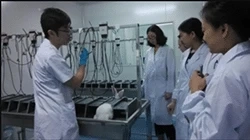Pyrogen testing defines a process used by drug manufacturers to determine if bacterial toxins are present in vaccines and drugs that might cause fever when used on humans. It determines if microbes or their metabolites are present in intravenous solutions during the manufacturing process. The most common and oldest form of pyrogen testing consists of injecting drugs into rabbits to determine if a fever develops. A newer test uses blood from the horseshoe crab to test for toxins.
Pyrogen test is performed to check the presence or absence of pyrogens in all aqueous parenterals. Rabbits are used to perform the test because their body temperature increases when pyrogen is introduced by parenteral route.
Pyrogen Testing Procedure
The sensitivity is 1pg/ml, the test result is close to the real condition of the human body, and the operation is tedious and time-consuming
- Rabbits for trial: 1.7~3.0 kg. The body temperature is 38~39.6℃, and the difference between the highest and lowest body temperature is no more than 0.4℃. It can be used after resting for 48 hours.
- Experimental preparation: The room temperature is 17~25℃, and the temperature change should not exceed 3℃.
- Inspection: 3 pieces. The medicine solution warmed to 38℃ is injected into the ear vein. It is measured every 30 minutes, 6 times. The normal body temperature is subtracted from the highest one of the 6 body temperatures, which is the temperature at which the rabbit’s body temperature rises.
- Judgment: The body temperature rise of 3 animals is lower than 0.6℃, and the total body temperature rise of 3 animals is lower than 1.4℃.
For this test three healthy rabbits are selected each weighing at least 1.5 kg. No rabbit should be selected if:
1. It has normal temperature greater than 49.8°C.
2. It was used in positive test during last two weeks or negative test during last two days.
Pyrogen in Parenterals Method for Pyrogen Test:
The pyrogen testing is performed in an air conditioned room. The food and water is withheld to rabbit overnight. Clinical thermometer is inserted in the rectum of each rabbit to a depth of not less than 7.5 cm. Two readings of temperature of rabbit in normal conditions should be taken at the interval of half an hour before start the test and mean of the both should be calculated to determine the initial temperature.
The equipments, injectors and needles used in the test should be pyrogen free. These should be washed with water for injection and then heated at 260°C for two hours. The injection is warmed to 38°C before inject to the rabbits. 0.5 to 1.0 ml per kg dose should be injected through the ear vein. Six reading of temperature are recorded at an interval of half an hour.
Pyrogen Test Results:
The response of each rabbit is detected by difference of initial temperature and the highest temperature recorded. The response of all three rabbits gives the sum of responses and can be concluded as:
i) If the sum of responses dose not greater than 1.4°C and any of rabbit shows the response less than 0.6° C, the product passes the test.
ii) I sum of responses is greater than 1.4 °C or any of rabbit shows the response 0.6 or greater, continue the test using 5 rabbits.
iii)If test is done using 5 rabbits, than if sum of responses of all 5 rabbits is greater than 3.7°C and the individual response of not more than three rabbits is greater than 0.6°C, the product passes the test.



